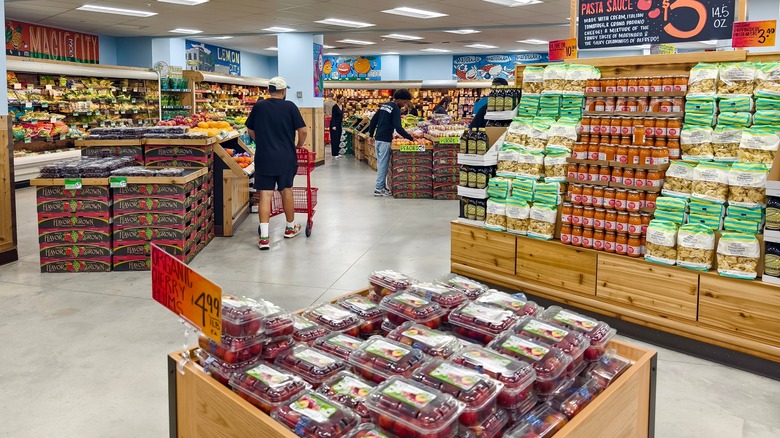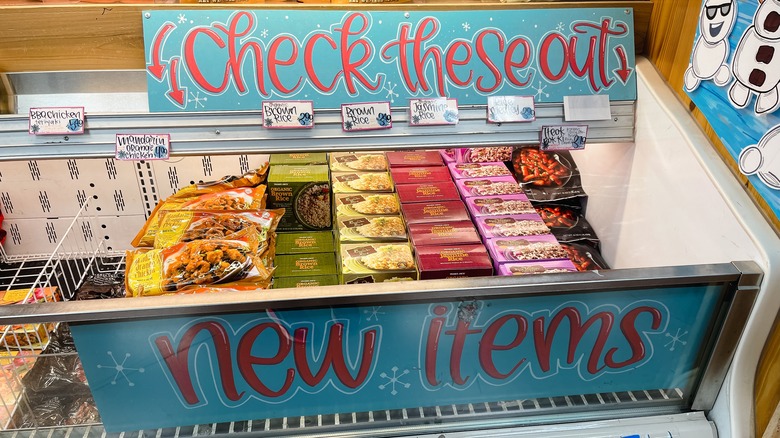Why Trader Joe's Appears More Expensive Than It Is
Trader Joe's has built a loyal fanbase, though many shoppers remain skeptical. The perception that it's a high-end or expensive store persists, despite anecdotal evidence and actual comparisons that tell a different story. Of course, what defines "expensive" varies, and a sense of value is going to be as unique as a grocery list among shoppers. Still, the question of why Trader Joe's is viewed as a pricier grocery store is worth asking — although there isn't any one answer that explains it away. It's likely a combination of location, demographics, and their products.
The company has said that looking at factors like visibility and accessibility help them to decide where to open stores, rather than demographics or the economic profile of the area. But research has shown that stores tend to be located in more affluent areas, and the average shopper earns over $80,000 per year. Then there are the products themselves. Trader Joe's offers a curated selection of private-label items only available in-store. The limited selection and exclusivity, as well as the brand's focus on specialty items, like gourmet cheeses, exotic snacks, and organic produce, may also contribute to their upscale reputation. Finally, the packaging is designed to be visually appealing and distinctive, which can also add to the perception of premium quality. However, the truth is, Trader Joe's is frequently comparable to or cheaper than other stores, though certain products and shopping trips may be exceptions, particularly for larger families.
How Trader Joe's actually compares to other stores
Trader Joe's operates in more than 40 states across the U.S. — there are just eight states without a single store — so comparisons that match every shoppers experience are impossible. However, plenty of shoppers find that Trader Joe's prices are generally less expensive than other local stores. Other studies have found that Trader Joe's prices are around 20% less than average, with one CNET report citing a 33% savings compared to other stores. Some specific items that tend to be cheaper at Trader Joe's include eggs, wine, produce, and frozen items.
What Trader Joe's lacks can make it more expensive, however. For instance, most items are not designed for large families, with many products having just one or two servings. A family of four or more will need to buy more, with no bulk options available in Trader Joe's. The store doesn't take coupons or run sales, which may make certain items less expensive elsewhere when a sale is going on. Finally, Trader Joe's is much smaller than traditional grocery stores, with a far more limited selection. You will likely have to hit at least one other store to get everything on your list. These factors can mean that it's not an ideal one-stop shop for many customers.
How Trader Joe's keeps prices low
Many of the things that make Trader Joe's beloved and unique contribute to the brand's ability to keep prices low. One significant factor is the size of their stores — some of the most unique Trader Joe's stores are also the tiniest. Trader Joe's stores are famously smaller than other grocery chains, which reduces overhead costs. Those savings are passed on to customers through lower prices. Another key strategy is the focus on private label products. The majority of what you'll find in a store will be from Trader Joe's own brand, which eliminates the middleman and allows the company to negotiate directly with suppliers. This equals cost savings, and it ensures quality control and the niche items fans are accustomed to.
Trader Joe's maintains a streamlined inventory with fewer items than larger grocery stores. The limited selection reduces storage and stocking costs and allows for better prices on the items they do carry. Additionally, the chain prefers to source certain freshly made items regionally, which reduces transportation costs and supports local economies. By purchasing seasonal and local products, they can offer fresh items at competitive prices. These strategies empower shoppers to find high-quality products at lower cost. On top of these savings, shoppers can also take advantage of the store's lenient return policy to try new items without the fear of wasting money.


